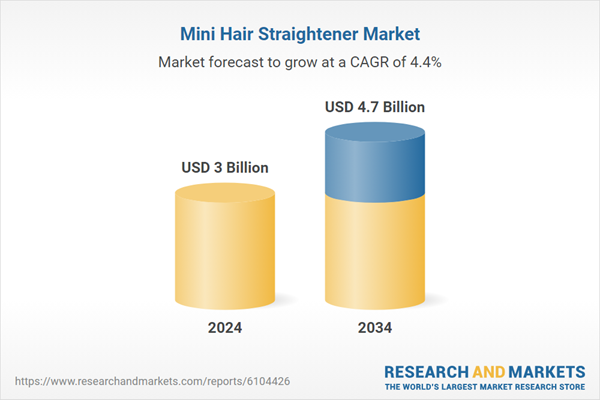Current designs are equipped with fast-heating elements, moisture-locking capabilities, automatic shutoff features, and protective ceramic or tourmaline-coated plates to minimize hair damage. Urban professionals and on-the-go users are particularly drawn to premium-grade, multi-functional tools. E-commerce platforms have become a vital growth channel, with top brands offering bundled kits and special pricing to increase visibility and customer reach. The rising influence of digital content, such as styling tutorials and influencer reviews, continues to enhance awareness and drive sales in this niche category.
The flat irons and straightening brushes segment held a market value of USD 1 billion in 2024 and is projected to reach USD 1.5 billion by 2034. These tools dominate the market due to their user-friendliness and effective results on various hair textures. Flat irons remain favored for producing sleek styles, and their continued popularity stems from improvements in material technology that reduce heat-related damage.
Tourmaline and ceramic coatings are commonly used to protect hair strands while delivering salon-quality results. Their practicality, especially in smaller designs suited for travel or quick styling needs, maintains strong consumer interest. Ongoing developments in temperature regulation, compact design, and fast-heating functions will continue supporting growth in this segment.
The ceramic plates segment reached a value of USD 1 billion in 2024 and is expected to grow at a CAGR of 4.1% during 2025-2034. Consumers prefer ceramic plates due to their ability to distribute heat, which helps avoid hot spots that can cause hair breakage. These features make ceramic-coated mini straighteners ideal for regular use, especially for individuals with fine to medium-density hair. Their smooth glide over strands helps reduce frizz while promoting healthier styling. The combination of reliable performance, affordability, and ease of access makes these tools attractive to beginners and casual users. Their design also caters to those who prioritize gentle styling in a compact format.
U.S. Mini Hair Straightener Market was valued at USD 0.48 billion in 2024 and is expected to grow at a CAGR of 4.8% through 2034. Market expansion in the U.S. is driven by innovation, urban lifestyles, and consumer demand for sleek, portable beauty tools. A large population in fast-paced metropolitan areas contributes to the need for efficient grooming products.
Domestic and international brands continue to invest in product development, focusing on cutting-edge technologies like rapid heat systems and safer plate materials that align with growing health consciousness. The well-established beauty industry infrastructure, alongside rising digital adoption, supports the consistent introduction of smart styling tools tailored to evolving consumer expectations.
Key players active in the Mini Hair Straightener Market include Philips, Vega, Conair, Revlon, Moehair, Dyson, T3 Micro, Ikonic, Panasonic, RUSK, John Paul Mitchell, Adawo, Braun, Hot Tools, and Drybar. To strengthen their market footprint, companies are focusing on advanced product innovation, including lightweight designs, dual-voltage compatibility, and temperature customization. Strategic partnerships with influencers and beauty professionals help promote product visibility across digital platforms.
Many brands are bolstering their e-commerce strategies through exclusive bundles, targeted promotions, and faster shipping options. Sustainability is also becoming a differentiating factor, with several firms exploring recyclable packaging and energy-efficient devices. R&D investment continues to rise as companies prioritize user-friendly, tech-enhanced tools to meet global consumer preferences for compact, high-performance hair styling solutions.
Comprehensive Market Analysis and Forecast
- Industry trends, key growth drivers, challenges, future opportunities, and regulatory landscape
- Competitive landscape with Porter’s Five Forces and PESTEL analysis
- Market size, segmentation, and regional forecasts
- In-depth company profiles, business strategies, financial insights, and SWOT analysis
This product will be delivered within 2-4 business days.
Table of Contents
COMPANIES MENTIONED
The companies featured in this mini hair straightener market report include:- Adawo
- Braun
- Conair
- Drybar
- Dyson
- Hot Tools
- Ikonic
- John Paul Mitchell
- Moehair
- Panasonic
- Philips
- Revlon
- RUSK
- T3 Micro
- Vega
Table Information
| Report Attribute | Details |
|---|---|
| No. of Pages | 220 |
| Published | June 2025 |
| Forecast Period | 2024 - 2034 |
| Estimated Market Value ( USD | $ 3 Billion |
| Forecasted Market Value ( USD | $ 4.7 Billion |
| Compound Annual Growth Rate | 4.4% |
| Regions Covered | Global |
| No. of Companies Mentioned | 16 |









